Changchun
| Changchun 长春 |
|
| — Sub-provincial city — | |
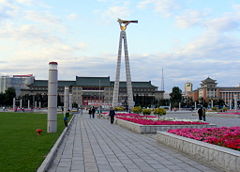 |
|
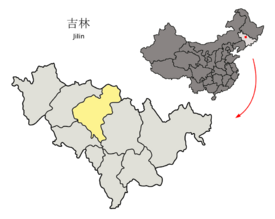 |
|
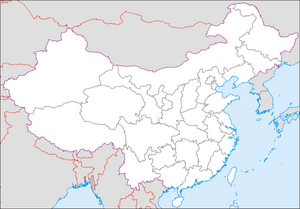 Changchun
|
|
| Coordinates: | |
| Country | China |
|---|---|
| Province | Jilin |
| County-level divisions | 10 |
| Area | |
| - Sub-provincial city | 20,532 km² (7,927.4 sq mi) |
| - Urban | 3,616 km² (1,396.1 sq mi) |
| Elevation | 222 m (730 ft) |
| Population (2000) | |
| - Sub-provincial city | 7,135,439 |
| - Density | 347.5/km² (900.1/sq mi) |
| - Urban | 2.125.497 |
| - Urban Density | 0/km² (0/sq mi) |
| Time zone | China Standard Time (UTC+8) |
| Postal code | 130000 |
| Area code(s) | 431 |
| License plate prefixes | 吉A |
| GDP (2004) | CNY 115 billion |
| - per capita | CNY 21,336 (2003) |
| Website: www.changchun.gov.cn (Chinese) | |
Changchun (traditional Chinese: 長春; simplified Chinese: 长春; pinyin: Chángchūn; literally "Long Spring") is the capital and largest city of Jilin province, located in the northeast of the People's Republic of China, in the centre of the Songliao Plain. It is a sub-provincial city. The name originated from the Jurchen language. As of 2000, Changchun has a population of 7.1 million, including counties and county-level cities. The urban districts have a total population of 3.2 million.
Contents |
History
Changchun is a new city with only about 200 years of history. Changchun started as a minor trading town. In 1800, Emperor Jiaqing of the Qing Dynasty selected a small village on the east bank of the Yitong River and named it "Changchun Ting." In 1889, it was promoted as "Changchun Fu".
It expanded rapidly as the junction between of the Japanese-owned South Manchurian Railway and the Russian-owned Chinese Eastern Railway which had different rail gauges, as well as permit licences, from 1905-1935. Changchun had railway repair shops and branch lines originating in Changchun extended into Korea and Inner Mongolia In 1932 moving from Jilin City (Kirin city) 200 km to the east, Changchun became the capital of Manchukuo, a state in Manchuria. Then known as Hsinking 新京 (Pinyin: Xīnjīng, Wade-Giles: Hsin-ching, Japanese: Shinkyō, English trans.: New Capital), the capital was a well-planned city with broad avenues and modern public works. The city underwent rapid expansion in both its economy and infrastructures.
From 1931 to 1945 China's last emperor Pu Yi was installed as the Manchukuo government head by the Japanese authority. He resided in the Imperial Palace (帝宮) which is now the Museum of the Manchu State Imperial Palace (偽滿皇宫博物院).
Severely damaged during World War II, the city was liberated by the Soviet Red Army in 1945. The Russians maintained a presence in the city after the Chinese civil war until 1956. Kuomintang forces occupied the city in 1946, but were unable to hold the countryside against Chinese Communist forces. The city fell to the communists in 1948 after a 12-month-long siege by the People's Liberation Army that resulted in a massive famine with a civilan death toll of 100,000 to 300,000. Renamed Changchun by the People's Republic of China government, it became the capital of Jilin in 1954.
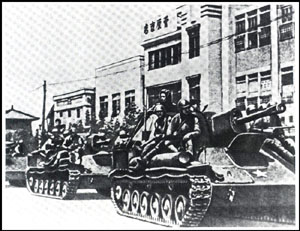
The Changchun Film Studio is also one of the remaining film factories of the era. From the 1950s, it was designated to become a center for China's automotive industry. The famous Red Flag limousines were made in Changchun as were the Liberation (Jiefang) trucks based on a Ford model used in Russia who supplied much of the early manufacturing machinery.
Changchun hosted the 2007 Winter Asian Games.
Administration
The prefecture-level city of Changchun administers 10 county-level divisions, including 6 districts, 3 county-level cities and 1 county.
- Nanguan District (南关区)
- Kuancheng District (宽城区)
- Chaoyang District (朝阳区)
- Erdao District (二道区)
- Lvyuan District (绿园区)
- Shuangyang District (双阳区)
- Jiutai City (九台市)
- Yushu City (榆树市)
- Denghui City (德惠市)
- Nong'an County (农安县)
Economy

Changchun is situated at Northeast Asia's geometric center. South Liaodong peninsula coastline, north to Russia and Eastern Europe, east to North Korea, South Korea, Russia, and west to Mongolia. Changchun is a important transportation and communication hub of Northeast China.
Changchun's main industry is the manufacturing of transportation facilities and machinery. It produces 20%, 50%, and 10% of all automobiles, passenger trains, and tractors made in China.
Changchun is the biggest automobile research and development center in China. The first Chinese truck and car was made in Changchun. FAW (First Automotive Works) Group is headquartered in Changchun. The automaker's factories and associated housing and services occupies a substantial portion of the city's southwest end. Specific brands produced in Changchun includes the Red Flag luxury brand, as well as joint ventures with Audi, Volkswagen, and Toyota.
The GDP per capita was ¥21336 (ca. US$2580) in 2003, ranked no. 52 among 659 Chinese cities.
Changchun hosts the yearly Changchun International Automobile Fair, Changchun Film Festival, Changchun Agricultural Fair, Education Exhibition and the Sculpture Exhibition.
Industrial zones
- Changchun High-tech Industrial Development Zone
- Changchun Economic & Technological Development Zone
Transportation
Changchun is served by a comprehensive bus system, as well as one traditional tram route (route 54). Most buses and the tram charge 1 Yuan (元) per ride. Changchun also has as a modern light rail line that began revenue service in 2002 and is undergoing extension. Private automobiles are becoming very common on the city's congested streets. Bicycles are relatively rare compared to other northeastern Chinese cities, but mopeds, as well as pedal and even animal-drawn carts are relatively common.
Changchun has three passenger rail stations, though most trains only stop at the central Changchun Railway Station (长春站), where there are multiple daily departures to other northeast cities such as Jilin City, Harbin, Shenyang, and Dalian, as well as Beijing.
Changchun Longjia International Airport, located well to the east of the city, has flights to cities across eastern and central China, as well as Seoul, South Korea and Tokyo, Japan.
Universities and Colleges
- Jilin University (吉林大學)
- Northeast Normal University (東北師范大學)
- Changchun University of Technology (長春工業大學)
- Changchun University of Science and Technology (長春理工大學)
Sister cities
 Birmingham, United Kingdom
Birmingham, United Kingdom Flint, Michigan
Flint, Michigan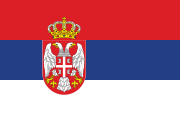 Novi Sad, Serbia
Novi Sad, Serbia Québec City, Québec, Canada
Québec City, Québec, Canada Ulsan, South Korea (since 1994)
Ulsan, South Korea (since 1994) Windsor, Ontario, Canada
Windsor, Ontario, Canada Žilina, Slovakia
Žilina, Slovakia
See also
- Changchun Light Rail Transit
- Changchun Tram
- Jilin City
- Harbin
- Shenyang
- Dalian
- Tonghua
External links
|
|||||||||||||||||||||
|
||||||||||||||||||||||||
